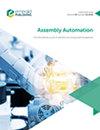Push recovery control for the underactuated lower extremity exoskeleton based on improved capture point concept
IF 1.7
4区 计算机科学
Q3 AUTOMATION & CONTROL SYSTEMS
引用次数: 2
Abstract
Purpose The purpose of this paper is to use a simple method to enhance the ability of lower limb exoskeletons to restore balance under large interference conditions and to solve the problem that biped robot stability criterion cannot be fully applied to the underactuated lower limb exoskeletons. Design/methodology/approach The method used in this paper is to construct an underactuated lower extremity exoskeleton ankle joint with a torsion spring. Based on the constructed exoskeleton, the linear inverted torsion spring pendulum model is proposed, and the traditional capture point (CP) concept is optimized. Findings The underactuated exoskeleton ankle joint with torsion springs, combined with the improved CP concept, can effectively reduce the forward stepping distance under the same interference condition, which is equivalent to enhancing the balance ability of the lower extremity exoskeleton. Originality/value The contribution of this paper is to enhance the balance ability of the exoskeleton of the lower limbs under large interference conditions. The torsion spring is used as the exoskeleton ankle joint, and the traditional CP concept is optimized according to the constructed exoskeleton.基于改进捕获点概念的欠驱动下肢外骨骼推复控制
目的用一种简单的方法提高下肢外骨骼在大干扰条件下恢复平衡的能力,解决两足机器人稳定性准则不能完全应用于欠驱动下肢外骨骼的问题。设计/方法/方法本文中使用的方法是用扭转弹簧构建一个欠驱动的下肢外骨骼踝关节。在构建的外骨骼基础上,提出了线性倒立扭转弹簧摆模型,并对传统的捕获点(CP)概念进行了优化。Findings带扭转弹簧的欠驱动外骨骼踝关节,结合改进的CP概念,可以在相同干扰条件下有效减少向前步进距离,相当于增强了下肢外骨骼的平衡能力。原创性/价值本文的贡献在于增强了下肢外骨骼在大干扰条件下的平衡能力。外骨骼踝关节采用扭转弹簧,并根据构建的外骨骼对传统的CP概念进行了优化。
本文章由计算机程序翻译,如有差异,请以英文原文为准。
求助全文
约1分钟内获得全文
求助全文
来源期刊

Assembly Automation
工程技术-工程:制造
CiteScore
4.30
自引率
14.30%
发文量
51
审稿时长
3.3 months
期刊介绍:
Assembly Automation publishes peer reviewed research articles, technology reviews and specially commissioned case studies. Each issue includes high quality content covering all aspects of assembly technology and automation, and reflecting the most interesting and strategically important research and development activities from around the world. Because of this, readers can stay at the very forefront of industry developments.
All research articles undergo rigorous double-blind peer review, and the journal’s policy of not publishing work that has only been tested in simulation means that only the very best and most practical research articles are included. This ensures that the material that is published has real relevance and value for commercial manufacturing and research organizations.
 求助内容:
求助内容: 应助结果提醒方式:
应助结果提醒方式:


